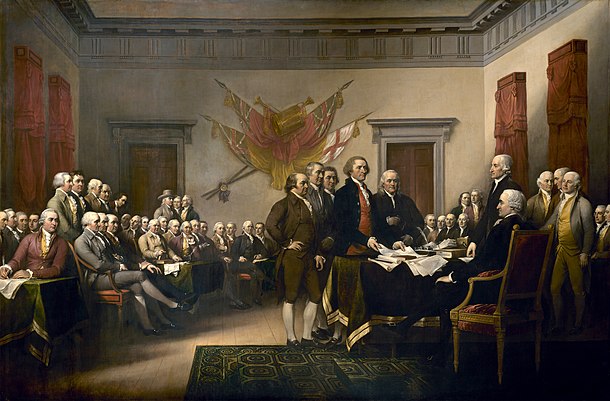
It’s a colossal work of art – 18 feet long and 12 feet high.
John Adams, who is depicted standing heroically dead center, called it the “Shin Painting.” That’s because once it was mounted on the wall of the US Capitol building rotunda, where it remains to this day, the typical viewer would be staring directly at his shins.
There was another reason Adams was displeased with John Trumbull’s iconic depiction of the presentation of the draft of the Declaration of Independence.
It was historically absurd. Nothing like it ever happened. Trumbull accurately painted the faces of 42 of the 56 signers of the Declaration. But during the tumultuous summer of 1776, there was never a moment in which more than half of those men were in the same place at the same time.
That was understandable. It was a dangerous and unpredictable time. The signers were committing treason against Britain, and they knew it. If caught by the King’s troops, their property would be confiscated, their families subjected to poverty, and their necks placed within a noose. In the sobering words of Ben Franklin, “We must all hang together or assuredly we shall all hang separately.”
Trumbull’s painting debuted in 1826, just in time for the celebration of the 50th anniversary of the Declaration. The birth of America had forever changed the world.
But Adams was a stickler for historical accuracy. He lamented that public mythmaking had already misrepresented the legacies of the Founders. George Washington, James Madison, Thomas Jefferson and the others were becoming larger-than-life, semi-miraculous figures, instead of real-life individuals – blessed with extraordinary gifts and burdened by ordinary sins – who actually pioneered the American Experiment.
The painting commemorates something that happened on June 28, 1776, when the five-man drafting committee presented their final edited version of the Declaration to John Hancock, who is shown seated, in the presence of a few members of the Second Continental Congress. Standing left to right, the committee members are Adams, Roger Sherman, Robert R. Livingston (who, interestingly, never signed the document he helped draft), Jefferson, and Franklin.
The Congress voted its final approval on July 2. That was the date everyone assumed would become America’s birthday. On July 3, Adams wrote to his wife Abigail, “The second day of July 1776 will be the most memorable Epocha in the History of America.” It turned out he was off by two days, and for a rather odd reason: John Dunlap, a Philadelphia printer, produced the first copies of the Declaration of Independence on July 4. Because that date was affixed to his document, it eventually became our national holiday.
The members of the Continental Congress quickly dispersed to their homes across the colonies.
Hancock boldly added his signature to the radical document early in July, but the official period of signing didn’t begin until August 2. After that, the 55 other “revolutionaries and conspirators” affixed their autographs over a period of weeks and months, whenever they happened to be in Philadelphia. The last signature wasn’t added until 1781 – a point at which one could safely say that America’s ragtag troops had somehow won their independence, and the time of extreme danger had passed.
Adams and Jefferson outlived everyone else in Trumbull’s painting. Theirs was an extraordinary relationship.
As young friends they labored side-by-side for the Revolution. At midlife they became bitter political rivals. In their final years they reconciled (at least in part) and sustained a decade and a half of correspondence unlike anything else in American history.
Benjamin Rush, one of the other signers, famously described Adams and Jefferson, respectively, as the north and south poles of the Revolution. What was the true meaning of 1776? Each man had his own take. Jefferson was incurably idealistic, always seeing rainbows. Adams was relentlessly realistic, always acknowledging the rain clouds. Jefferson believed the Revolution was a world-changing force that could never be stopped. Adams asserted that America’s amazing achievements could still run off the rails. It would all depend on her citizens.
Knowing that the two Founders had had a prickly relationship, some observers of Trumbull’s painting came to believe that the artist deliberately depicted Jefferson stepping on Adams’ shoe. But it isn’t so. In the unlikely event that you have a two-dollar bill in your wallet right now, you can see for yourself (since the painting adorns the flip side of that currency). The Virginian’s foot is merely in the vicinity of the Bostonian’s.
It seems incredible, but the two old patriots died on the same day – July 4, 1826, America’s 50th birthday.
Jefferson’s last words were, “Is it the Fourth?” Not knowing that his friend and nemesis had already preceded him in death, Adam’s last words were, “Thomas Jefferson survives.”
John Adams insisted that historical details matter. Americans don’t need myths or contrived, grandiose paintings to improve on the remarkable things that actually happened.
He also wrote, towards the end of his life, that the future would decide whether the American beginning was “either the brightest or the blackest page in human history.” What he meant is that it is possible to receive an incredible gift – such as becoming the first nation that would dare to suggest all human beings are created equal – and then struggle to actually live that out.
It falls to us, 246 years later, to help ensure that those words from the preamble of the Declaration of Independence jump off the page and into our lives.
“Blessed is the nation whose God is the Lord” (Psalm 33:12).
May God bless us this holiday weekend in our stewardship of the remarkable legacy we have all received.
